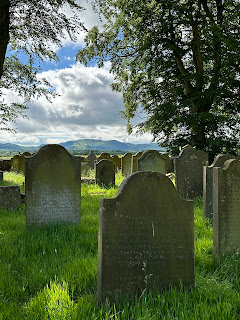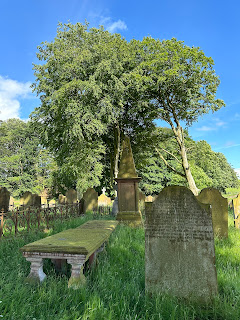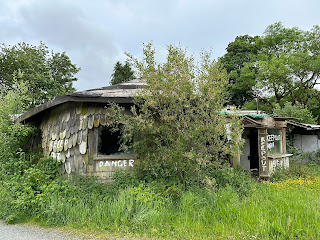On
a sunny morning during a stay in Kirkcudbright I decided to pay a visit to
Tongland. Yes, Tongland is a real
place. Sounds made up I know, but it
does exist. It is a small village just
outside Kirkcudbright with a few houses, a derelict church, a rather stunning
looking Modernist style hydro power station (unfortunately hidden under
scaffolding and sheeting during my visit to the area), and the remains of an
ancient abbey that I fancied taking a look at.
On
leaving the Airbnb I was staying in, I walked along to the harbour and then
took the path along by the River Dee.
Passing a small industrial estate area where in one of the units they
make all that lovely fake food you see on the tables of various popular period dramas;
I reached a more rural area of reeds and muddy banks. Then making my way up and into fields of
cows, past the remains of an old railway embankment and back to a path by the
river, I ended up across from the power station. Here the path I was walking on became
narrower and more overgrown. Wondering
if I’d taken a wrong turning somewhere I decided to carry on regardless and
thankfully soon came out on a proper, well-trodden path again that led me to a
bridge over the river. A little bit
further with a stint along the main road and I was walking down a small
residential street and into the grounds of the old and now derelict Tongland
Parish Church. Here in the graveyard,
not far from the church, stand the last remains of the old abbey.
Tongland
Abbey was founded in around 1218 by Alan, Lord of Galloway. He, at this time, was one of the most
powerful men in the whole of the British Isles who owned huge tracts of land in
Scotland, England and Ireland. A
relative, friend and confidant of King John of England, he was one of the
King’s advisers in 1215 negotiating the terms of the Magna Carta.
For
over three hundred years the abbey was home to the Canons of the
Premonstratensian Order who were also known as the much easier to pronounce
‘White Canons’ due to the colour of their habit. The Premonstratensian Order were founded in
1120 by Norbert of Xanten, later Saint Norbert, at Premontre in France - hence
the name. Once an impressive set of
buildings with the tallest spire in Galloway, all that remains of the abbey now
are a wall and arched doorway that were incorporated into a later church. This church, also a ruin, is now no more than
some walls and a belfry.
The
history of Tongland Abbey is a relatively peaceful one, though in 1235 during
an uprising in Galloway against King Alexander II, royal troops killed both the
Prior and Sacristan of the abbey. Then
in 1455 King James II used the abbey as his base while his troops carried out a
siege on the nearby stronghold of the Douglas family, Threave Castle. Other than that, the Canons carried on doing
the things that Canons do.
There
was however one rather colourful character who briefly occupied the role as
Abbot at Tongland, this being John Damien.
He was an Italian, or maybe French alchemist, though malicious rumours
were spread by his enemies that he was actually a ‘Mohammedan’ from Turkey who
had murdered an Italian monk and stolen his habit. On being discovered he had fled to France
where still in monks garb, he passed himself off as a man of medicine. There, he fleeced his patients out of
exorbitant amounts of money and killed so many with his pills and potions that
he had again to flee and ended up in Scotland.
Probably none of this is true, but he certainly did experiment with
alchemy in an attempt to make gold from base metals. He also tried to find potions that would make
old men young, ill men well and one that would kill lice, a huge and itchy
problem back then.
Damien
became a favourite of King James IV and would often be invited to play cards
and backgammon with him. He regularly
took part in shooting matches with the King, using the primitive firearms of
the day. The King liked to wager large
amounts of money on these matches, and he usually lost to Damien. This however did not dampen the King’s
affection for him and in 1504 he appointed Damien the Abbot of Tongland. Whether Damien ever visited the abbey or just
claimed a big fat wage from it, we don’t know.
It did appear though that he didn’t have a great deal of interest in
carrying out his role and spent most of his time either carrying our various
experiments in alchemy or enjoying himself at the King’s court.
In
1508, much to the amusement of his enemies…and his friends, Damien decided to
experiment in flying. He had a large
pair of wings made with feathers sown into them and had these attached to his
arms. Then, in the first recorded
attempt at flight in Scotland, he jumped off the walls at Stirling Castle. Yup, you guessed it, he didn’t fly. He went down, down, down and then SPLAT he
landed in a dung heap. He survived the
fall but was out of action for a while with a broken thigh bone. On recovering, Damien carried on much as he
had before, but then after the Battle of Flodden in 1513 his name disappears
from the records. It is assumed that he
died in the battle along with his friend and benefactor King James.
The
history of the abbey during the 16th century appears to have been
one of decline with the buildings being recorded as in a poor condition in 1529
when they came under the care of the Bishop of Galloway. By the time of the Scottish Reformation the
religious community at the abbey had gone, and in 1587 the buildings and land
around became the property of the Crown.
The abbey is recorded as still standing in 1684 but shortly after this
appears to have been dismantled with the stone being used to build a nearby
bridge and other buildings.
The
graveyard in which the remains of the abbey stand is dominated by the derelict
building of Tongland Parish Church. This
church was built in 1813 and then abandoned in the 1930s. Since then, it has slowly fallen to bits and
is now a roofless shell. There was some
talk of it being restored and used as an exhibition space, but this has never
come to anything.
Wandering
around the graveyard I came across the slightly creepy Neilson Mausoleum from
which three white marble faces stare out.
This is the burial place of James Beaumont Neilson, the inventor of the
hot-blast process for smelting iron, his wife Barbara Montgomerie and their son
Walter Montgomerie Neilson, an engineer who founded the largest firm of
locomotive and marine engine manufacturers in Europe. All three at one time lived in and owned a
nearby estate. Peering in through the
barred gate of the mausoleum I felt that the ivy creeping around Barbara’s face
and obscuring her almost seemed to symbolise how the history of her life is
lost in that of the two ‘great men’ she sits between.
After
a stroll through the graveyard, I made my way back to the abbey remains and
there I left a Skulferatu balancing precariously in a gap in the wall. I hope it doesn’t fall.
The
coordinates for the location of the Skulferatu are -
I used the
following sources for information on Tongland Abbey -































































